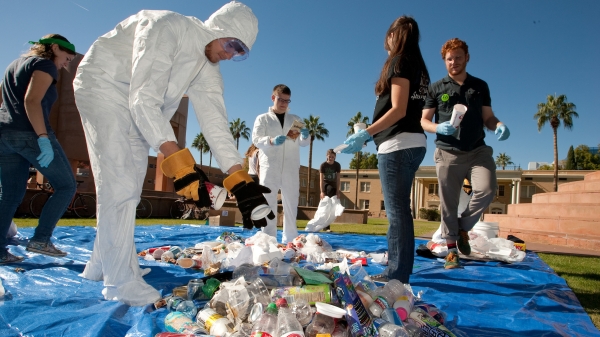After Paris, the first steps
ASU-led workshop teaches city officials from around the globe how to inventory sources of greenhouse gas emissions

The Paris climate talks last December were a lot like graduation.
First, elation. Almost 200 countries reaching an agreement! Finally, victory after the disappointments in Kyoto and Copenhagen! There’s hope!
Then, depression. Reduction targets will be voluntary. Countries aren’t obligated to put their climate action plans into actual action. Is anything really going to get done, by anybody?
Yes. And the first steps are being helped out by Arizona State University’s Julie Ann Wrigley Global Institute of Sustainability.
Last month more than 20 city officials from around the world attended a training workshop in Washington, D.C., to learn how to inventory sources of greenhouse gas emissions.
Once that task is complete, they can knuckle down to the task of eliminating the worst offenders.
Twenty-one city officials attended, from countries including Argentina, India, South Africa, Korea, Bolivia, China and Bangladesh. They had titles including senior engineer, project monitor and secretary of the environment.
All of them were World Bank clients. The World Bank mainly finances Third World infrastructure projects. Bank officials are concerned about the effect of climate change on projects they’ve financed.
Of the more than 180 countries that agreed to the Paris accords, the World Bank works with more than 130 of them.
“In terms of the World Bank, they want to loan money to their clients who are going to mitigate climate impacts,” said Raj Buch, who led the workshop. “If they teach them the right way to do the inventory, they’ll prioritize the right things to fix in their local communities.”
Buch is a practice lead for the Sustainability Solutions Extension Service, a consulting group within ASU that provides customized advice and practical solutions to business and government sectors applying university-based research, knowledge and capabilities.
“The course was to teach them how to do that inventory,” Buch said.
The officials will look at landfills, transportation, mass transit, industry.
“These are the different things that are emitting greenhouse gases into the atmosphere,” Buch said. “When you do this inventory, you’ll identify all the hot spots for these emissions. ... If you’re producing a lot of methane gas in a landfill, you’re not going to put the organic material in the landfill. You need to collect that methane, suck it out of the landfill and convert it to energy.”
The World Bank put a priority on starting these inventories after Paris. Bank officials approached the school and asked it to design a curriculum and deliver the class. The bank invited the participants to the workshop in Washington.
After they return home and complete their work, they’ll be able to return to the bank and present their case for a loan to solve the most pressing issues.
Buch earned a doctorate in sustainability at ASU. Part of his job is to apply the theories he learned to the daily life of a business, individual or organization. By analyzing daily functions with a sustainability perspective, Buch and his teams can help organizations envision sustainable futures; teach employees how to communicate sustainability to clients; upgrade facilities with more efficient technologies; or develop sustainable products.
Buch said the course will be produced in an online format so it can go to scale, as well as being cost- and time-effective.
“It will be developed for online delivery so people can do it on their own time and pass the test and become certified,” he said.
Although the workshop is happening quickly after the Paris talks in December, ASU has been preparing for it for longer than that.
“This is something ASU had led with for 10 years, and it’s finally starting to take hold,” Buch said.
Top photo by Corne Snijders
More Environment and sustainability

Celebrating Earth Day around the world
Originating in the United States in 1970, Earth Day is now celebrated worldwide. But even before it became an official day, many countries were already mindful of their carbon footprint in their…

A run on fossil fuels: ASU professor says climate legislation could have unintended consequences
As concerns about climate change grow, policymakers are increasingly voicing support for stricter fossil fuel legislation. Their discussions and proposals raise questions about the future of the oil…

Confusion complicates US recycling efforts
In most major cities and buildings, recycling bins can often be found alongside trash bins in an effort to encourage recycling. But is it working? According to the U.S. Environmental Protection…